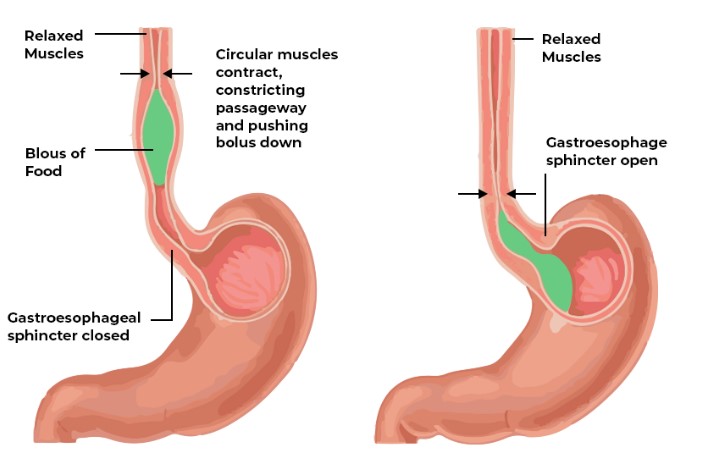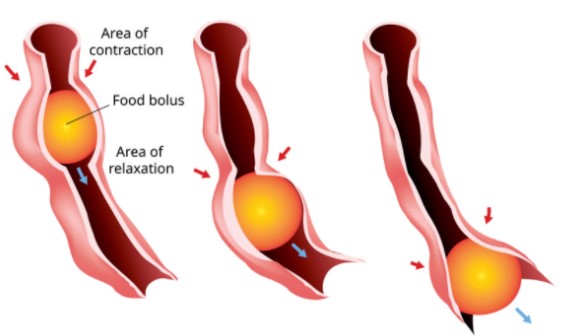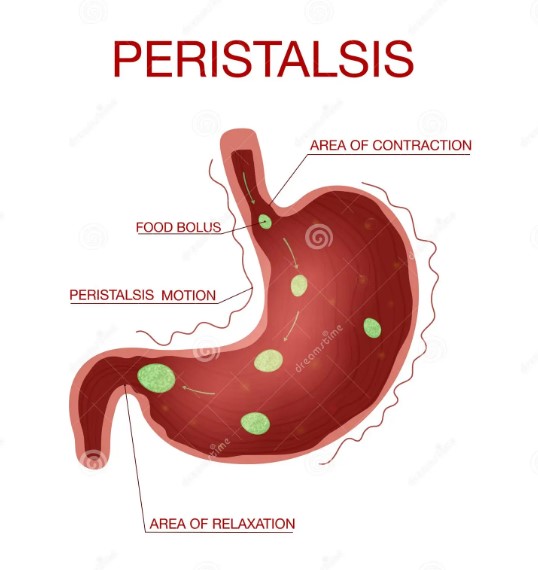The human body operates through a series of intricate processes, many of which occur without our conscious effort. Among these, the movements that propel substances through the organs, particularly in the digestive system, are vital yet often overlooked. Two such movements are peristalsis and antiperistalsis, both of which play crucial roles in our well-being but function in notably different ways.
Peristalsis refers to the wave-like muscle contractions that move food through the digestive tract, whereas antiperistalsis involves the reverse movement, typically seen in the process of vomiting. While peristalsis is a forward-moving process that helps in the digestion and absorption of food, antiperistalsis works in the opposite direction, often as a body’s response to irritants or harmful substances.
The significance of these processes extends beyond their immediate roles in digestion. Peristalsis and antiperistalsis are essential for maintaining the balance and efficiency of the body’s digestive and excretory systems. Their coordination ensures that nutrients are absorbed, waste is expelled, and that the body can defend itself against potential toxins, illustrating the complex yet fascinating nature of human physiology.

What is Peristalsis?
Definition and Role in the Digestive System
Peristalsis is a fundamental biological process that occurs within the digestive tract. It involves the sequential contraction and relaxation of muscle layers in the esophagus, stomach, and intestines, propelling food and liquid through the digestive system. This movement is crucial for the digestion of food and the absorption of nutrients.
How Peristalsis Works
The process of peristalsis begins when food enters the esophagus. Here’s how it works:
- Muscle Contraction: The circular muscles behind the food mass contract, narrowing the esophagus and pushing the food downward.
- Muscle Relaxation: Simultaneously, the muscles ahead of the food mass relax, allowing the digestive tract to expand and accommodate the forward movement of food.
Biological Significance
The biological significance of peristalsis lies in its role in efficient digestion and nutrient absorption. Without peristalsis, the body would not be able to move food through the digestive system, leading to nutritional deficiencies and gastrointestinal disorders.
What is Antiperistalsis?
Definition and Function
Antiperistalsis is the reverse of peristalsis. This process involves the backward movement of contents within the digestive tract. While less common than peristalsis, antiperistalsis plays a critical role in certain body functions, such as vomiting, which expels toxic substances from the body.
Mechanism of Action
Antiperistalsis follows a similar mechanism to peristalsis but in the opposite direction. Here’s a simplified breakdown:
- Muscle Contraction: Begins in the lower part of the digestive tract, with muscle contractions pushing contents upward.
- Muscle Relaxation: As the contraction moves upwards, the muscles below relax, facilitating the backward movement of contents.
Contexts and Conditions Where Antiperistalsis Occurs
Antiperistalsis typically occurs in response to irritants or toxins in the stomach or when the body needs to expel indigestible substances. It is a protective mechanism that prevents harm from toxic substances.
Key Differences
Direction of Movement
- Peristalsis: Moves contents forward through the digestive tract.
- Antiperistalsis: Moves contents backward, often resulting in vomiting.
Functional Roles in the Body
- Peristalsis: Essential for digestion and nutrient absorption.
- Antiperistalsis: Acts as a defense mechanism, expelling harmful substances.
Physiological Triggers
- Peristalsis: Triggered by the presence of food in the digestive system.
- Antiperistalsis: Often triggered by irritants or toxins.
Peristalsis in Detail
Anatomical Sites of Occurrence
Peristalsis occurs throughout the digestive system, from the esophagus to the intestines, each segment playing a vital role in moving food and waste.
Stimuli Initiating Peristalsis
The primary stimulus for peristalsis is the presence of food in the digestive tract, which activates nerve signals that trigger muscle contractions.
The Process of Peristaltic Movement
Here’s a step-by-step overview of peristaltic movement:
- Step 1: Food enters the esophagus.
- Step 2: Circular muscles contract behind the food bolus, pushing it downward.
- Step 3: Longitudinal muscles ahead of the bolus contract, shortening the path forward.
- Step 4: The cycle repeats, moving the food through the stomach and into the intestines for nutrient absorption.

Antiperistalsis in Detail
Antiperistalsis, as previously mentioned, involves the reverse movement of digestive contents. This section delves into the specifics of antiperistalsis, including its occurrences, triggers, and overall impact on health.
Specific Instances of Occurrence
Antiperistalsis is most commonly associated with vomiting but can occur in other contexts, such as:
- Reverse peristalsis in the intestines, often in response to obstruction or irritants.
- Regurgitation in some animals as part of feeding practices or digestive aid.
Causes and Triggers
Triggers for antiperistalsis include:
- Gastrointestinal irritants: Consuming spoiled food or toxins.
- Emotional stress: Strong emotions can trigger a physical response.
- Physical obstruction: Blockages in the digestive tract can reverse the normal flow.
Impact on Digestion and Health
While antiperistalsis plays a protective role, its frequent occurrence can indicate health issues, such as:
- Dehydration and electrolyte imbalance due to vomiting.
- Digestive system distress, signaling underlying conditions.
Comparative Analysis
To clearly distinguish between peristalsis and antiperistalsis, a comparative analysis is essential. This section highlights the key differences and provides examples of conditions affecting both processes.
Table Summarizing the Differences
| Feature | Peristalsis | Antiperistalsis |
|---|---|---|
| Direction | Forward movement | Reverse movement |
| Role | Digestion and absorption | Expulsion of toxins |
| Triggers | Presence of food | Irritants or stress |
Examples of Conditions Affecting Both Processes
- Gastroesophageal Reflux Disease (GERD): Affects peristalsis by causing backward flow of stomach acids.
- Intestinal Obstructions: Can trigger antiperistalsis leading to vomiting.
Health Implications
Understanding the disorders related to peristalsis and antiperistalsis is crucial for early detection and treatment.
Disorders Related to Peristalsis
Disorders include:
- Achalasia: Affects the esophagus, hindering food movement to the stomach.
- Irritable Bowel Syndrome (IBS): Alters the speed of food movement through intestines.
Disorders Related to Antiperistalsis
Key disorders involve:
- Cyclic Vomiting Syndrome: Recurrent episodes of severe vomiting with no apparent cause.
- Food Poisoning: Triggers antiperistalsis as a defense mechanism against toxins.
Diagnostic and Treatment Approaches
Diagnosis often involves:
- Endoscopy: Examining the digestive tract.
- Manometry: Measuring muscle contractions in the esophagus.
Treatment varies, including:
- Medications: To regulate muscle contractions or address symptoms.
- Surgery: For physical obstructions or structural abnormalities.
Prevention and Management
Lifestyle and dietary adjustments can significantly impact the management and prevention of disorders associated with peristalsis and antiperistalsis.
Dietary and Lifestyle Changes
Recommendations include:
- Fiber-rich diet: Enhances digestive health and peristalsis.
- Hydration: Maintains electrolyte balance, especially important after episodes of antiperistalsis.
- Stress management: Reduces the triggers of antiperistalsis.
Medical Interventions
When lifestyle adjustments are insufficient, medical interventions may include:
- Prokinetic drugs: Improve the efficiency of peristalsis.
- Anti-emetics: Reduce the frequency of vomiting in antiperistalsis-related conditions.
Importance of Early Detection
Early detection and treatment of disorders related to peristalsis and antiperistalsis are crucial for:
- Preventing complications: Such as malnutrition or dehydration.
- Enhancing quality of life: Through effective symptom management.
Frequently Asked Questions
What triggers peristalsis?
Peristalsis is typically triggered by the presence of food in the digestive tract. When food enters the esophagus, it stimulates the muscle layers to contract in a coordinated fashion, propelling the food towards the stomach. This action is an automatic response, highlighting the body’s sophisticated method of ensuring nutrients are efficiently processed.
How does antiperistalsis differ from vomiting?
While antiperistalsis is a reverse movement of contents through the digestive tract, it is not synonymous with vomiting. Vomiting is the forceful expulsion of stomach contents through the mouth, often triggered by nausea and involving a complex set of reflexes. Antiperistalsis, however, may occur in different parts of the digestive system and does not always result in vomiting.
Can peristalsis be felt by an individual?
In most cases, peristalsis is not felt by individuals due to its smooth and continuous nature. However, certain conditions, such as gastrointestinal disorders or obstructions, may cause painful or exaggerated peristaltic movements that can be felt as cramping or spasming.
What health conditions affect peristalsis?
Several health conditions can affect peristalsis, including gastroesophageal reflux disease (GERD), irritable bowel syndrome (IBS), and intestinal obstructions. These conditions can lead to either an increase or decrease in peristaltic activity, resulting in symptoms such as heartburn, constipation, or diarrhea.
Conclusion
The dance between peristalsis and antiperistalsis within our bodies is a testament to the complexity and efficiency of human physiology. These processes not only underscore the importance of the digestive system’s functionality but also highlight the body’s natural mechanisms for maintaining health and balance. Recognizing their roles provides us with deeper insights into our health and the importance of nurturing our bodies through proper nutrition and lifestyle choices.
Understanding the nuances of peristalsis and antiperistalsis enriches our appreciation for the body’s internal workings. It encourages a proactive approach to health, reminding us of the delicate balance that sustains life. As we navigate through our daily lives, acknowledging and respecting this balance can lead us towards healthier choices and a deeper connection with our bodily functions.

